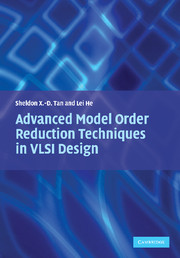Book contents
- Frontmatter
- Contents
- Figures
- Tables
- Foreword
- Acknowledgments
- 1 Introduction
- 2 Projection-based model order reduction algorithms
- 3 Truncated balanced realization methods for MOR
- 4 Passive balanced truncation of linear systems in descriptor form
- 5 Passive hierarchical model order reduction
- 6 Terminal reduction of linear dynamic circuits
- 7 Vector-potential equivalent circuit for inductance modeling
- 8 Structure-preserving model order reduction
- 9 Block structure-preserving reduction for RLCK circuits
- 10 Model optimization and passivity enforcement
- 11 General multi-port circuit realization
- 12 Reduction for multi-terminal interconnect circuits
- 13 Passive modeling by signal waveform shaping
- References
- Index
Foreword
Published online by Cambridge University Press: 19 January 2010
- Frontmatter
- Contents
- Figures
- Tables
- Foreword
- Acknowledgments
- 1 Introduction
- 2 Projection-based model order reduction algorithms
- 3 Truncated balanced realization methods for MOR
- 4 Passive balanced truncation of linear systems in descriptor form
- 5 Passive hierarchical model order reduction
- 6 Terminal reduction of linear dynamic circuits
- 7 Vector-potential equivalent circuit for inductance modeling
- 8 Structure-preserving model order reduction
- 9 Block structure-preserving reduction for RLCK circuits
- 10 Model optimization and passivity enforcement
- 11 General multi-port circuit realization
- 12 Reduction for multi-terminal interconnect circuits
- 13 Passive modeling by signal waveform shaping
- References
- Index
Summary
Interconnect model reduction has emerged as one crucial operation for circuit analysis in the last decade as a result of the phenomenon of interconnect dominance of advanced VLSI technologies. Because interconnect contributes to a significant portion of the system performance, we have to take into account the coupling effects between subcircuit modules. However, the extraction of the coupling renders many small fragments of parasitics. While the values of the parasitics are small, the number of fragments is huge and this makes the accumulated effect non-negligible. If left untreated, the amount of parasitics can gobble up the memory capacity and consume long CPU time during circuit analysis.
Model reduction transforms a system into a circuit of much smaller size to approximate the behavior of the original description. Many researchers have contributed to the advancement of the techniques and demonstrated drastic reduction of the circuit sizes with satisfactory output responses in published reports. Many of these techniques have also been implemented in software tools for applications. However, it is important for the users to understand the techniques in order to use the package properly. To adopt these approaches, we need to inspect the following features.
Efficiency of the reduction: the complexity of the reduction algorithm determines the CPU time of the model reduction. The size of the reduced circuit affects the simulation time.
[…]
- Type
- Chapter
- Information
- Advanced Model Order Reduction Techniques in VLSI Design , pp. xv - xviPublisher: Cambridge University PressPrint publication year: 2007



